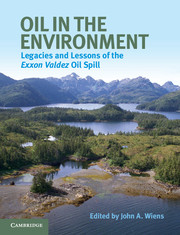Book contents
- Frontmatter
- Contents
- List of contributors
- Use of acronyms
- Acknowledgments
- A bibliographic note
- Prologue
- Part I Introduction and background
- Part II Oil in the environment
- Part III Biological effects
- Part IV Assessing oil spill effects and ecological recovery
- 16 Characterizing ecological risks, significance, and recovery
- Part V Conclusions
- Index
- References
16 - Characterizing ecological risks, significance, and recovery
Published online by Cambridge University Press: 05 July 2013
- Frontmatter
- Contents
- List of contributors
- Use of acronyms
- Acknowledgments
- A bibliographic note
- Prologue
- Part I Introduction and background
- Part II Oil in the environment
- Part III Biological effects
- Part IV Assessing oil spill effects and ecological recovery
- 16 Characterizing ecological risks, significance, and recovery
- Part V Conclusions
- Index
- References
Summary
Introduction
When the Exxon Valdez oil spill occurred in 1989, there was no accepted framework for conducting ecological risk assessments. The primary guidance for assessing effects from oil spills was Oil in the Sea (National Research Council, 1985), which emphasized individual species but provided little information on communities or ecosystem processes. More importantly, it did not provide a systematic, risk-based methodology for assessing relationships between exposures to oil and their effects. The United States Environmental Protection Agency's (EPA) risk-assessment framework had been developed specifically for determining human cancer risks from chemical exposures (National Research Council, 1983). Assessing ecological risks, however, presents significant additional challenges: diverse ecological systems are subjected to multiple natural and anthropogenic stressors, each potentially causing many different effects on many different ecological attributes. Consequently, EPA developed a new framework and guidance designed for conducting ecological risk assessments (ERAs) (US Environmental Protection Agency, 1992, 1998), but this did not occur until several years after the Exxon Valdez oil spill.
Another decade passed before we applied this ERA framework to evaluate the ecological significance of any remaining effects of the Exxon Valdez spill. Now, 20 years after the ERA framework was developed, the process has matured considerably into an integrated environmental-assessment framework (Cormier and Suter, 2008). The integrated framework no longer simply assesses exposures and effects, but now provides a more comprehensive approach to thinking about ecological incidents. This expanded construct focuses on identifying the system attributes that matter ecologically or societally and provides a means to assess both immediate and long-term effects on those important attributes. It also places spill risks in the context of other natural and anthropogenic stressors and incorporates a process to account for uncertainty. It ultimately provides a means to characterize recovery in light of natural variability over time.
- Type
- Chapter
- Information
- Oil in the EnvironmentLegacies and Lessons of the Exxon Valdez Oil Spill, pp. 383 - 419Publisher: Cambridge University PressPrint publication year: 2013
References
- 3
- Cited by



